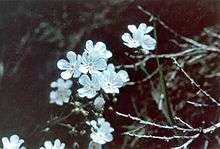Hackelia cronquistii
Hackelia cronquistii is a species of flowering plant in the borage family known by the common name Cronquist's stickseed.
| Hackelia cronquistii | |
|---|---|
 | |
| Scientific classification | |
| Kingdom: | Plantae |
| Clade: | Tracheophytes |
| Clade: | Angiosperms |
| Clade: | Eudicots |
| Clade: | Asterids |
| Order: | Boraginales |
| Family: | Boraginaceae |
| Genus: | Hackelia |
| Species: | H. cronquistii |
| Binomial name | |
| Hackelia cronquistii J.L.Gentry | |
This species was formerly treated as a variety of Hackelia patens, until elevated to its own species status in 1972.[1]
Distribution
It is endemic to Oregon and Idaho in the Great Basin region and the Northwestern United States. It is native to a small area around the Oregon−Idaho border.[2][3] It was known from just one population until 1982, when more were found.[3] It was thought to be just from Oregon until 1993, when it was found in Idaho.[1] There are about 52 populations known today. Though endemic to only the one small region and a listed Vulnerable species, it is considered locally stable.[2]
It It grows on sandy soils in sagebrush scrub habitat dominated by Artemisia tridentata.[3]
Associated plant species include Achillea millefolium, Achnatherum hymenoides, Arabis sp., Balsamorhiza sagittata, Chrysothamnus viscidiflorus, Crepis acuminata, Ericameria nauseosa, Eriophyllum lanatum, Erysimum capitatum, Festuca idahoensis, Leymus cinereus, Lupinus argenteus, Phlox longifolia, Poa secunda, Pseudoroegneria spicata, and Purshia tridentata.[1]
Description
Hackelia cronquistii is a perennial herb growing up to 65 centimeters tall, growing from a taproot and branching caudex. The erect stems are lightly hairy toward the top and hairless near the bases. The leaves near the base of the plant are up to 21 centimeters long and 3.5 wide. They become smaller farther up the stem. The forget-me-not flowers are blue-tinged white and measure up to 1.5 centimeters wide. Flowering occurs mainly in May. The fruit is a small nutlet.[2]
References
- Hackelia cronquistii. Oregon Department of Agriculture.
- Hackelia cronquistii. The Nature Conservancy.
- Hackelia cronquistii. Archived 2011-10-26 at the Wayback Machine Center for Plant Conservation.
